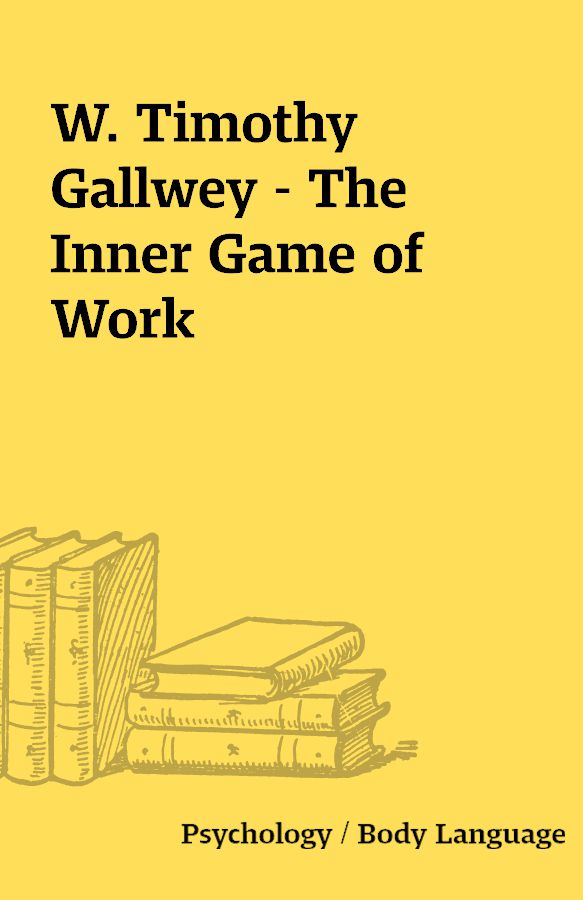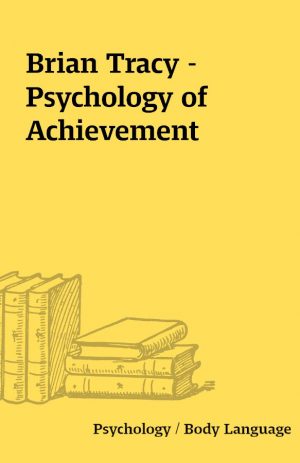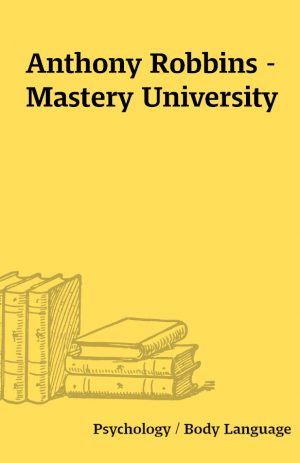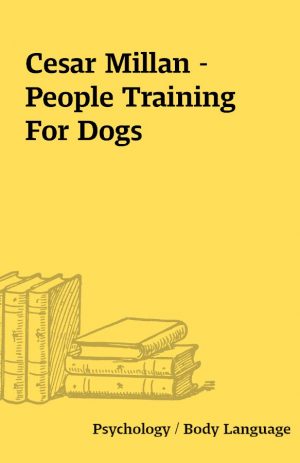W. Timothy Gallwey – The Inner Game of Work
W. Timothy Gallwey – The Inner Game of Work.pdf
[ebook – pdf]
Description
W. Timothy Gallwey – The Inner Game of Workhttp://www.amazon.com/gp/product/0375500073/104-8130598-1359124?v=glance&n=283155Amazon.comSince the publication some two decades ago of his bestselling The Inner Game of Tennis and The Inner Game of Golf, Timothy Gallwey has come to believe that those books’ overriding principle–eliminate negative internal interference to bring about positive self-change–is applicable to virtually any activity. Now, in The Inner Game of Work, he applies that principle to the arena where the biggest turn-of-the-millennium game of all is being played. “We are constantly told that we live in an age of change,” Gallwey writes, “and nowhere are we told more frequently that we have to change than in the workplace.” As on the court and the course, he contends, those changes necessary to survive and thrive can be effectively realized by quieting our inner doubts and learning to rely on our own natural instincts and behavior.How does Gallwey suggest we do this? His method is twofold: “focus of attention … the quintessential component of superior performance in every activity” and “clarity of desire behind the focus.” Through example and clear instruction, he shows how to minimize self-distracting thoughts that serve to undermine our confidence in the workplace and similar settings, and subsequently to begin “playing in the zone” like elite athletes who have learned to visualize their goals unerringly and proceed unremittingly (and almost unconsciously) in their pursuit. It will take no small amount of dedication to put these ideas into practice, but those who do should find that Gallwey’s advice relates as well to the working world as it does to the sporting world. –Howard RothmanFrom Library JournalGallwey, the best-selling author of The Inner Game of Tennis and The Inner Game of Golf, here applies his sports expertise to the workplace. As a consultant to Bell and AT&T, Gallwey devised and demonstrated methods to help employees excel by expanding constrictive work routines and engaging their intellect more fully by increasing their awareness of the tasks at hand. Gallwey conjectures that by focusing on one’s ability and becoming aware of distractions, one may become more fulfilled and, therefore, more successful at work. The book presents exercises to help understand and develop focus and can be a valuable tool for helping to bring about positive changes in attitudes and productivity through work satisfaction. Recommended for public, corporate, and academic libraries supporting business management.Robert L. Balliot Jr., Middletown P.L., RICopyright 2000 Reed Business Information, Inc. This book presents a fundamentally different view on working and learning. This other view leads to more pleasure, better performance and more effective learning in work. The ideas in this book are so powerful and relevant and Gallwey describes them so clearly that it seems virtually impossible nót to apply them. Gallwey’s core message is: the traditional way in which we try to improve ourselves and our performance -through (self-)instruction and supervision- blocks what we try to achieve. To be more specific: an instructive, controlling approach to performance improvement does not lead to better but to worse performance!After Gallwey finished his English study at Harvard University in the nineteen seventies, he went to work as a tennis coach. Doing that, he discovered that nearly all his pupils tried very hard to improve one aspect of there play that they did not like, for instance their backhand. They expected Gallwey to give them the remedy for their problem. First, this was exactly what he did: “hold your racket like this, stand there, hit the ball then”, etc. He instructed pupils but noticed that they showed resistance to his instructions and that their learning did not go well. Then he noticed, to his surprise, that the performance suddenly was better when pupils stopped trying so hard to correct their mistakes but instead just played tennis for fun. Based on this observation that the ‘forced mode’ of learning was less effective than the `natural’ mode Gallwey built his approach. His book `The Inner Game of Tennis’ became a bestseller.Gallwey proposed that the ineffective, instructive dialogue between coach and pupil also existed within the head of the pupil. While playing, the pupil continuously gave himself instructions and comments: “that was really bad, hold your racket like this, do this, don’t do that” etc. Gallwey called the coach inside the pupils head SELF-1. In Gallwey’s words: SELF-1 is the collection of internalised voices from the outside world. To whom then did this internal coach speak? According to Gallwey it spoke to the person him or herself. He called this spoken-to self the SELF-2. The best learning took place when SELF-1 was turned off. How is this possible? Gallwey’s answer: While SELF-1 is busy giving vague and (too) simple instructions, SELF-2 is doing something infinitely more complex and precise: computing the curve of the ball, instructing muscle groups, taking into account the wind speed, the speed of the ball, etc.Gallwey concluded that SELF-1 was a from of interference that led to nothing else than an underutilization of the person’s potential. In other words: Performance = Potential – Interference. In still other words: don’t let SELF-1 distract you from your task and goal!Gallwey formulated a different, more effective and more elegant way of coaching aimed at achieving three things: 1) Awareness: by letting SELF-2 do its work the pupil can focus on collecting information on the critical variables in the task (where is the ball landing? How fast is it going? How is it influenced by the wind? etc) which leads to a greater awareness of the task; 2) Choice: it is essential that the pupil determines what he or she wants to achieve. Without this choice there is no direction and focused attention is impossible; 3) Trust: trust yourself. This goes for both the coach and the pupil. This refers to the confidence that SELF-2 will be capable of fulfilling the task.Galwey gradually started to apply his approach to others field that tennis: golf, skiing, music and …work. He noticed that the effects were the same. For instance: a salesman who stopped instructing and commenting himself became more effective. In seminars Gallwey draws a triangle with on the corners the words: performance, learning en enjoyment. Gallwey claims that each of these are of great importance in work and that they are dependent on each other. When you neglect enjoyment, this will eventually also lead to performance problems. What Gallwey says about the relationship between performance and learning is interesting. Performance leads to an observable change in the external world. Learning, however, establishes a change within the person who learns. It is precisely because of this that learning results are hard to measure. Enjoymentis important according to Gallwey because it refers to the relationship the person has to him or herself. If you appreciate yourself, you won’t deny yourself enjoyment for a prolongued period.Since his discovery Gallwey’s most important ambition has been to let himself and others enjoy the freedom to express in their work who they really are and what they really want. He says that human freedom is nowhere more constrained than in the world of work. Nowadays, the most prevailing experience of work even seems to be: someting I’d rather not be doing if I had a choice. Gallwey says that striving for freedom at work is not the same as wanting to avoid responsibility or bosses. It is about choosing a way of working which shows responsibility to oneself. A way which is aligned with your choices and values. Gallwey uses the word ‘conformity’ to describe the situation when an individual gives priority to extranl demands above his internal fire. Doing this brings the security of doing and being like others but it puts out our internal fire and it diminishes our chance of satisfaction. If life decisions are based on external demands instead of internal demands, someting of the greatest value can be lost. The conflict between external and internal voices seems unfair. There is constant pressure from the outside world to conform. Sanctions, corrections, instructions, rewards, etc. are everywhere. The external world is so large and the internal so small. But the internal has one advantage: it is always there. An important step would be to understand why conformity is so attractive to us and how it affects our way of working. As an alternative to conformity Gallwey names its opposite ‘mobility’: the freedom to move in any direction without self-restriction.The central idea in this book is that there is a better way of thinking about working and learning that comes down to giving more priority to our inner capacities and whishes and less to external expectations, norms and instructions. I think this is a valuable book. The author gives good and convincing examples of the inner game, for instance applied to the field of sales. In this time of extreme change good and new ideas about how people can learn and perform are wellcome. Gallwey delivers this.
You must be logged in to post a review.






Reviews
There are no reviews yet.